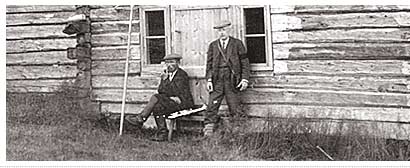

T.I. ITKONEN
![]()
 |
|||||
 |
|||||
T.I. ITKONEN |
|||||
|
|||||
|
|
|
|
|
|
|
|
On January 20, 1891, a third child was born to the current Assistant Vicar of Pulkkila, Lauri Arvid Itkonen. He would later come to greatly influence the documentation of the Sámi heritage and through this the Inari Sámi cultural heritage. The boy received the name Toivo Immanuel Itkonen who moved with his family to Inari in the spring-winter of 1899. He had just turned 8 years old then. The large family, counting the parents, two servants and six children, as well as a horse named Putte, altogether ten people, was greeted in Kittilä by the current parish clerk Heikki Mattus with his daughter Anna and a file of reindeer. Because there was still a circuit school system in use in Inari in the beginning of the last century and catechist Matti Lehtola then taught children in Inari, it still seemed the best alternative for Lauri Itkonen to hire a home tutor for his children Toivo and Tyyne who were then of school age. Their tutor’s name was Helmi Hirvonen. The family’s oldest child, Lauri Ilmari, was then studying in Oulu. He it was who would be the discoverer ten years later of the Stone Age village at the mouth of Juutua River, A primary school started functioning in the village of Inari in 1902 but Toivo Immanuel did not get to take part because he was to begin his studies in the Secondary School of Oulu in 1901. But his intentions of starting school there were not fulfilled that autumn because he did not pass the secondary school’s written entrance exam. One part of the exam was to know the multiplication table and he had started in descending order from 100 instead of ascending order from the number one. It did not pay to send the boy back to Inari and primary school, but the Oulu Finnish Preparatory School headmaster Magnus Rosendal enrolled him for one term, after which Toivo was admitted as a student into the Secondary School of Oulu. After seven years of study at the Secondary School he graduated in 1910 at19 years old. He received the Master of Arts degree in 1913, Licentiate of Philosophy in 1916, and his Doctorate in 1923. When the Doctor’s cap was placed on his head he was only 32 years old. He served as an assistant for the Archeological Committee 1919-1932, as curator 1932-1935 and department superintendent for the whole committee 1935-1955. He was secretary of the Finnish Archeological Society 1920-1933, as chairman of the Cultural Association of Lapland 1934-1961, member of the Finnish Academy of Science from 1947, honorary member of the Royal Anthropological Institute of Great Britain and Ireland as well as honorary member of the Norsk Folkemuseum from 1961. During the years 1911 -1949 he took 9 survey trips to Lapland resulting in a two-part work “The Finnish Lapps, I and II” in 1948, a two-part Skolt Sámi dictionary Koltan- ja kuolanlapin sanakirja (The Skolt and Kola Sámi Dictionary, I and II) in 1958, published a book Inarinlappalaista kansantietoutta (Inari Lapland Folklore) 1917 from material gathered by A.V. Koskimies in the summer of 1886, documented the life of the Sámis with about 400 photographs and registered about 2000 Inari Sámi place names. Uula Morottaja assisted him as expert in language and other matters for many years. As well as survey trips directed towards Lapland, he made similar trips to Central Europe in 1929, to Scandinavia in 1931 and 1947, and his last trip, to Italy, in 1955. Toivo Immanuel Itkonen and his wife Iina Amanda Seppänen had three children, Terho, Marja and Kerttu, the last of whom became a professor. Most of his life, T.I. Itkonen lived in Helsinki and as is evident from the above, he was a highly valued linguist and language researcher. He died in Helsinki on 5.12.1968. According to a lecture by Martti Linkola held at Siida in1998, he had written over 5000 pages of scientific text, although he was prone to express himself briefly. Terho Itkonen endowed a major part of her father’s books to Siida. |
| |||||||||||||||||||
| © 2006 Sámi musea Siida & Anarâškielâ servi siida@samimuseum.fi |